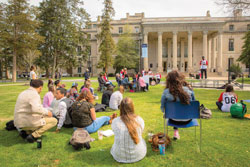A Free Online Learning Resource Serves as a Tool for Both Teachers and Students
Reaching a total of 1.4 million subscribers, the Khan Academy has marched forward on actualizing its mission to provide a “free world-class education to anyone, anywhere.”
The non profit website, led by ex-hedge fund analyst turned education pioneer Salman Khan, has uploaded over 3,840 YouTube mini-lectures spanning topics from K-12 math, calculus, physics, biology, chemistry, economics, finance, computer science, and world history. The ten-minute videos, which have garnered an impressive 312 million YouTube views, are only half of what the Khan Academy has to offer.
An infinite amount of unique problems can be generated to provide additional practice on mastering the material at hand. Not only do students have access to this expansive problem set, they also have step-by-step hints to understand the problem-solving process to get to the correct answers.
Though Khan’s idea of an online school is not unique, it is his lax teaching style and ability to explain difficult concepts in a concise manner that has allowed the website to gain the momentum it has now. The complex calculus problems manifested by Khan’s doodles with a pen tablet are recorded by screen capture software and narrated by his voice as he never shows himself on the camera.
“I like you better on YouTube than in person,” Khan’s cousin Nadia told him after watching his first tutorial on least common multiples. Despite its amusing sentiment, Nadia’s comment sheds light on an ulterior framework of thinking that Khan has been trying to understand and address.
The virtual classroom, unlike its physical counterpart, is free of the confines of social intimidation prevalent in typical classrooms where only a handful of students dare to ask questions. With the videos however, no instructor is asking “Do you understand this topic?” as he or she waits to begin covering the next set of lectures.
Students can, in the latter approach, engage in their own learning. They can pause lectures, rewind or forward through them, and replay them as many times as they need. If students forget certain concepts covered in the lecture, they can easily revisit previous videos to brush up on their foundation.
Dr. Danuta Szwajkajzer, chemistry professor at the University, thinks that Khan Academy will only grow in popularity in the upcoming future. “There are so many things that students need to learn. Books keep getting bigger and class time is not always enough to explain concepts in a way that all students can grasp immediately. Sometimes you just need a different perspective,” said Szwajkajzer. “The short visual explanations of Khan Academy are available online any time you need them, so why not try?”
Dorothy Cleary, Director of Tutoring and Writing Services, said, “The potential for the website is great, particularly as a supplemental resource for students trying to learn difficult concepts. I most often recommend it to students for physics, math and business related concepts, and also encourage my tutors to use it during their tutoring sessions to reinforce concepts.”
Cleary added, “I explain to students that this free resource gives them an opportunity to focus on concepts and get some review at their own pace, and it is readily available to them 24/7. Frequently, I log in and demonstrate one or more of the videos to the students and the reaction is always the same: ‘That’s so cool. I will definitely use that!’”
Szwajkajzer said, “I would definitely recommend [The Khan Academy] to all of my students, especially for chemistry.” She added, “Some students learn by listening in class, while others read textbooks or solve problems, sometimes [students] have to visually ‘see’ the concepts or need another approach or explanation. The Khan Academy is trying to present concepts in a way that anyone could understand, and seems to work for so many students.”
“My single biggest goal is to deliver things the way I wish they were delivered to me,” Khan said in an interview with The Chronicle for Higher Education. When unfamiliar with a topic he wants to teach, Khan gives himself a crash course first.
In an instance where he was preparing for a lecture on entropy, Khan said, “I took two weeks off and I just pondered it, and I called every professor and everyone I could talk to and I said, ‘Let’s go have a glass of wine about entropy.’ After about two weeks it clicked in my brain, and I said, ‘now I’m willing to make a video about entropy.’”
As it continues to grow in size and notoriety, the Khan Academy has challenged some of higher education’s most revered ideals: that Ph.D.’s make the best teachers, that 75 minute lectures are the ideal way to relate concepts, and that learning in lecture halls is better than through videos. Khan has argued that his lectures disprove these notions.
Henry Alcabes, junior accounting major at the University, believes that “Khan Academy provides an excellent way to either learn a new subject or just reinforce what you learned in a prior class. Plus, it is more trustworthy than Wikipedia.”
“Education,” said post-baccalaureate student Chris Mattielli, “has become a business. Outside of all the personal help Khan Academy has been for me, its biggest contribution is free, easy access to information and knowledge.”
Holding degrees in electrical engineering, mathematics, and computer science from MIT and an MBA from Harvard, Salman Khan has affected the lives of millions of students over the world as he moves forward in revolutionizing the face of education. Already, pilot programs have emerged in California where public schools are flipping the traditional classroom model.
Teachers are assigning Khan Academy lectures for homework and students are doing homework problems in the classroom, fostering a more personalized and collaborative atmosphere as a result.
Patrick Fedick, senior chemistry major, said, “Khan Academy saved my grade in calculus, physics and even general chemistry because the videos explained the content material extremely well. The lecturer is a bit dry and at times is repetitive, however, whenever I was stuck and there was a video on the topic, it was one of the first resources I went to.”
“Khan Academy,” Fedick said, “is really convenient because it also has videos that can be downloaded on your smartphone, so sometimes before an exam I would pull out my phone and watch a portion of them as a review.”
Despite the far-reaching impact of the Khan Academy, its humble origins stemmed merely from Khan’s efforts to make YouTube tutorials for his younger cousins. As random people started watching his videos, Khan became inspired by his new reach and continued producing videos, eventually completing the first math playlists.
His efforts became actualized not due to the success of the medium, but through the diligent tenacity with which he produced his lectures for the past decade.



